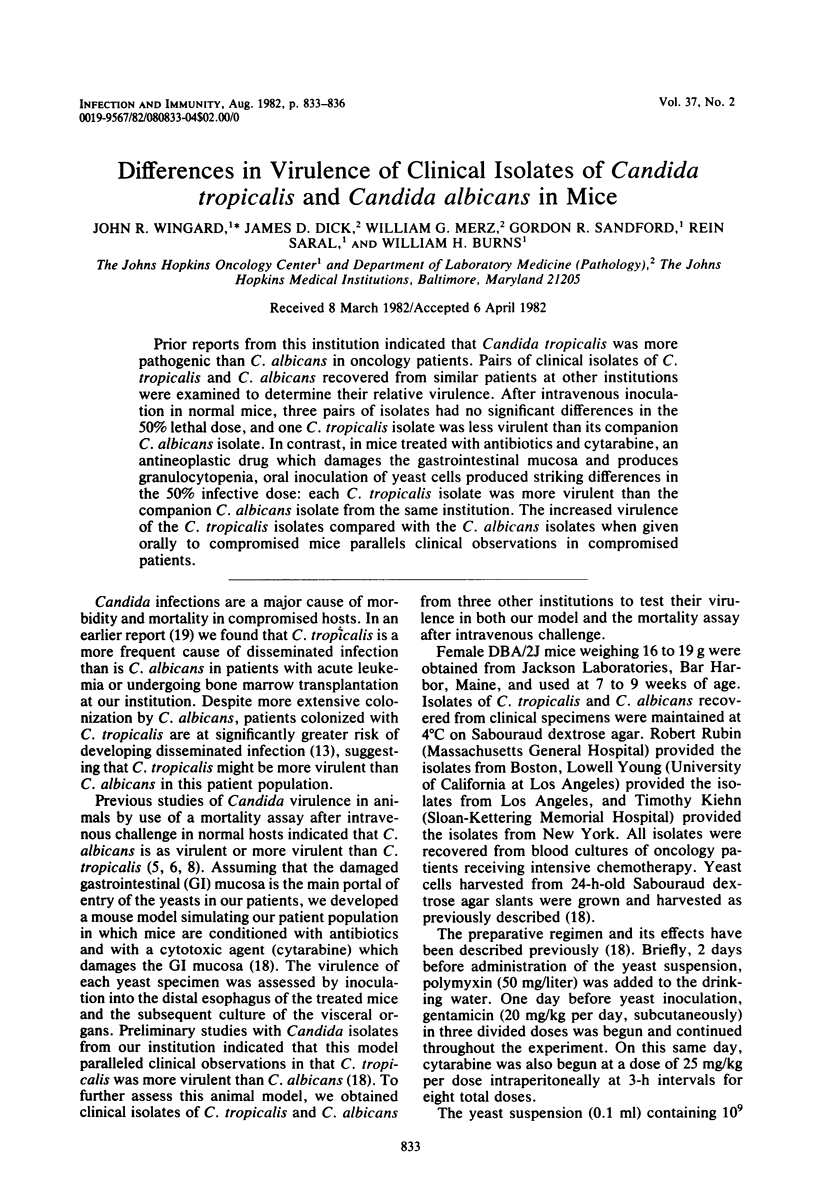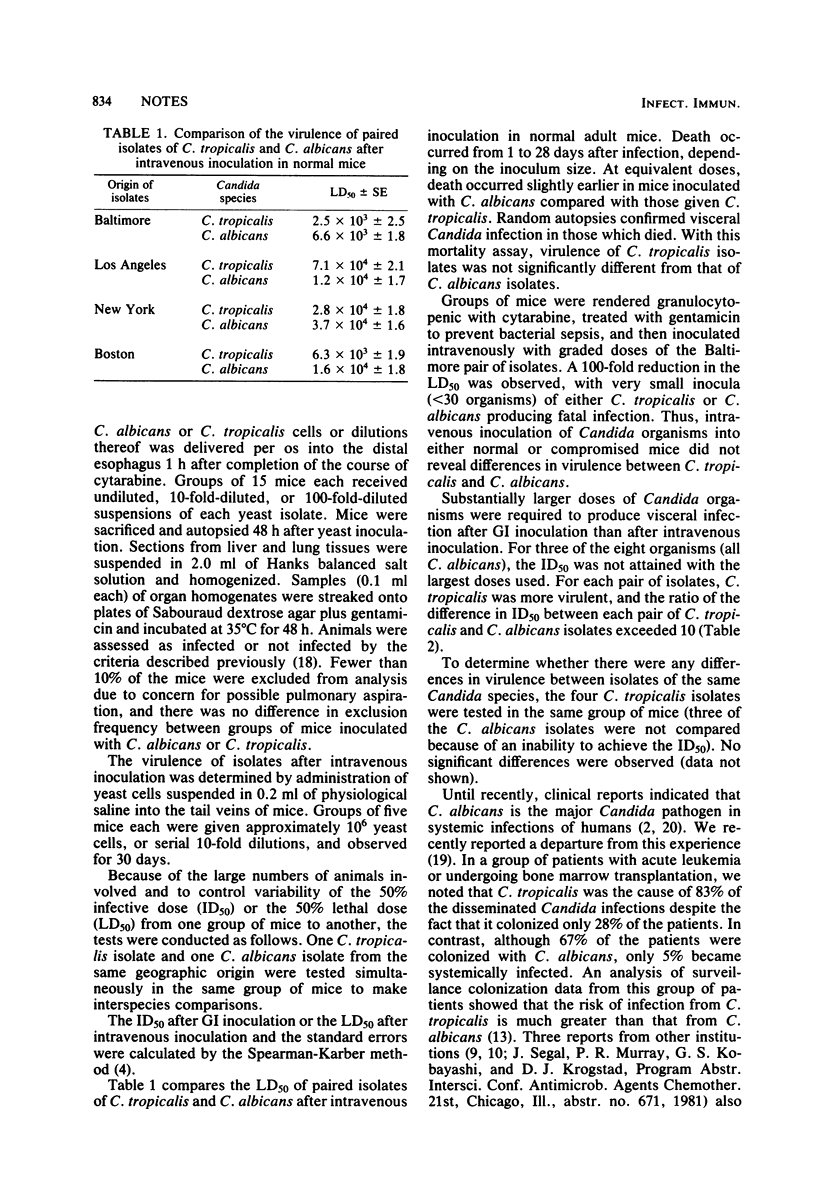Abstract
Prior reports from this institution indicated that Candida tropicalis was more pathogenic than C. albicans in oncology patients. Pairs of clinical isolates of C. tropicalis and C. albicans recovered from similar patients at other institutions were examined to determine their relative virulence. After intravenous inoculation in normal mice, three pairs of isolates had no significant differences in the 50% lethal dose, and one C. tropicalis isolate was less virulent than its companion C. albicans isolate. In contrast, in mice treated with antibiotics and cytarabine, an antineoplastic drug which damages the gastrointestinal mucosa and produces granulocytopenia, oral inoculation of yeast cells produced striking differences in the 50% infective dose: each C. tropicalis isolate was more virulent than the companion C. albicans isolate from the same institution. The increased virulence of the C. tropicalis isolates compared with the C. albicans isolates when given orally to compromised mice parallels clinical observations in compromised patients.
Full text
PDF



Selected References
These references are in PubMed. This may not be the complete list of references from this article.
- Balish E., Phillips A. W. Growth, morphogenesis, and virulence of Candida albicans after oral inoculation in the germ-free and conventional chick. J Bacteriol. 1966 May;91(5):1736–1743. doi: 10.1128/jb.91.5.1736-1743.1966. [DOI] [PMC free article] [PubMed] [Google Scholar]
- Bodey G. P. Infections in cancer patients. Cancer Treat Rev. 1975 Jun;2(2):89–128. doi: 10.1016/s0305-7372(75)80005-3. [DOI] [PubMed] [Google Scholar]
- Ezdinli E. Z., O'Sullivan D. D., Wasser L. P., Kim U., Stutzman L. Oral amphotericin for candidiasis in patients with hematologic neoplasms. An autopsy study. JAMA. 1979 Jul 20;242(3):258–260. [PubMed] [Google Scholar]
- HASENCLEVER H. F., MITCHELL W. O. Pathogenicity of C. albicans and C. tropicalis. Sabouraudia. 1961 Jan;1:16–21. [PubMed] [Google Scholar]
- HURLEY R., WINNER H. I. The pathogenicity of Candida tropicalis. J Pathol Bacteriol. 1962 Jul;84:33–38. doi: 10.1002/path.1700840104. [DOI] [PubMed] [Google Scholar]
- Krause W., Matheis H., Wulf K. Fungaemia and funguria after oral administration of Candida albicans. Lancet. 1969 Mar 22;1(7595):598–599. doi: 10.1016/s0140-6736(69)91534-7. [DOI] [PubMed] [Google Scholar]
- Louria D. B., Busé M., Brayton R. G., Finkel G. The pathogenesis of Candida tropicalis infections in mice. Sabouraudia. 1966 Jun;5(1):14–25. [PubMed] [Google Scholar]
- Meckstroth K. L., Reiss E., Keller J. W., Kaufman L. Detection of antibodies and antigenemia in leukemic patients with candidiasis by enzyme-linked immunosorbent assay. J Infect Dis. 1981 Jul;144(1):24–32. doi: 10.1093/infdis/144.1.24. [DOI] [PubMed] [Google Scholar]
- Meunier-Carpentier F., Kiehn T. E., Armstrong D. Fungemia in the immunocompromised host. Changing patterns, antigenemia, high mortality. Am J Med. 1981 Sep;71(3):363–370. doi: 10.1016/0002-9343(81)90162-5. [DOI] [PubMed] [Google Scholar]
- Myerowitz R. L. Gastrointestinal and disseminated candidiasis. An experimental model in the immunosuppressed rat. Arch Pathol Lab Med. 1981 Mar;105(3):138–143. [PubMed] [Google Scholar]
- Pope L. M., Cole G. T., Guentzel M. N., Berry L. J. Systemic and gastrointestinal candidiasis of infant mice after intragastric challenge. Infect Immun. 1979 Aug;25(2):702–707. doi: 10.1128/iai.25.2.702-707.1979. [DOI] [PMC free article] [PubMed] [Google Scholar]
- Sandford G. R., Merz W. G., Wingard J. R., Charache P., Saral R. The value of fungal surveillance cultures as predictors of systemic fungal infections. J Infect Dis. 1980 Oct;142(4):503–509. doi: 10.1093/infdis/142.4.503. [DOI] [PubMed] [Google Scholar]
- Stone H. H., Geheber C. E., Kolb L. D., Kitchens W. R. Alimentary tract colonization by Candida albicans. J Surg Res. 1973 Apr;14(4):273–276. doi: 10.1016/0022-4804(73)90028-0. [DOI] [PubMed] [Google Scholar]
- Stone H. H., Kolb L. D., Currie C. A., Geheber C. E., Cuzzell J. Z. Candida sepsis: pathogenesis and principles of treatments. Ann Surg. 1974 May;179(5):697–711. doi: 10.1097/00000658-197405000-00024. [DOI] [PMC free article] [PubMed] [Google Scholar]
- Stone H. H. Studies in the pathogenesis, diagnosis, and treatment of Candida sepsis in children. J Pediatr Surg. 1974 Feb;9(1):127–133. doi: 10.1016/0022-3468(74)90019-0. [DOI] [PubMed] [Google Scholar]
- Umenai T. Systemic candidiasis produced by oral Candida administration in mice. Tohoku J Exp Med. 1978 Oct;126(2):173–175. doi: 10.1620/tjem.126.173. [DOI] [PubMed] [Google Scholar]
- Wingard J. R., Dick J. D., Merz W. G., Sandford G. R., Saral R., Burns W. H. Pathogenicity of Candida tropicalis and Candida albicans after gastrointestinal inoculation in mice. Infect Immun. 1980 Aug;29(2):808–813. doi: 10.1128/iai.29.2.808-813.1980. [DOI] [PMC free article] [PubMed] [Google Scholar]
- Wingard J. R., Merz W. G., Saral R. Candida tropicalis: a major pathogen in immunocompromised patients. Ann Intern Med. 1979 Oct;91(4):539–543. doi: 10.7326/0003-4819-91-4-539. [DOI] [PubMed] [Google Scholar]
- Young R. C., Bennett J. E., Geelhoed G. W., Levine A. S. Fungemia with compromised host resistance. A study of 70 cases. Ann Intern Med. 1974 May;80(5):605–612. doi: 10.7326/0003-4819-80-5-605. [DOI] [PubMed] [Google Scholar]


